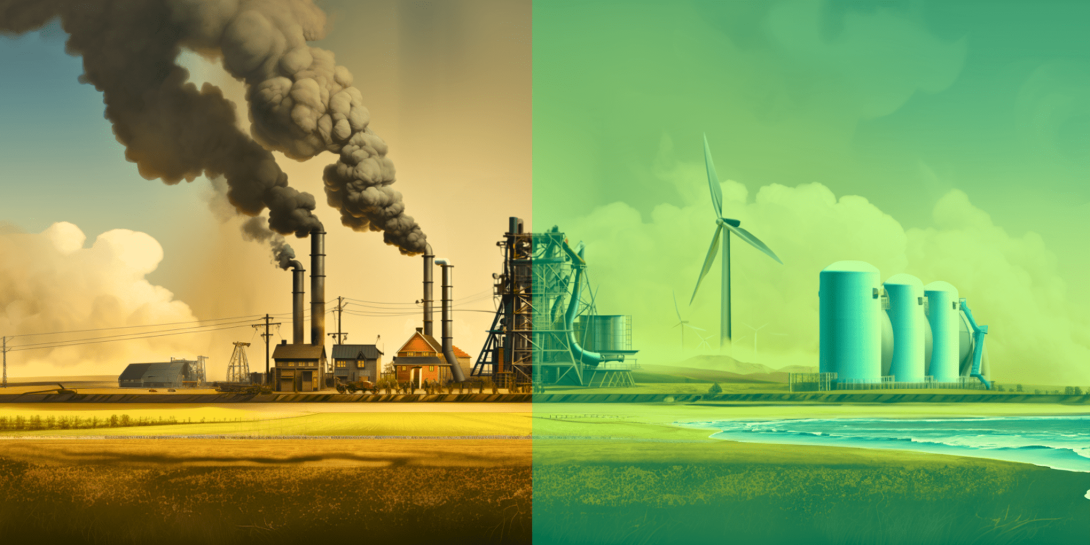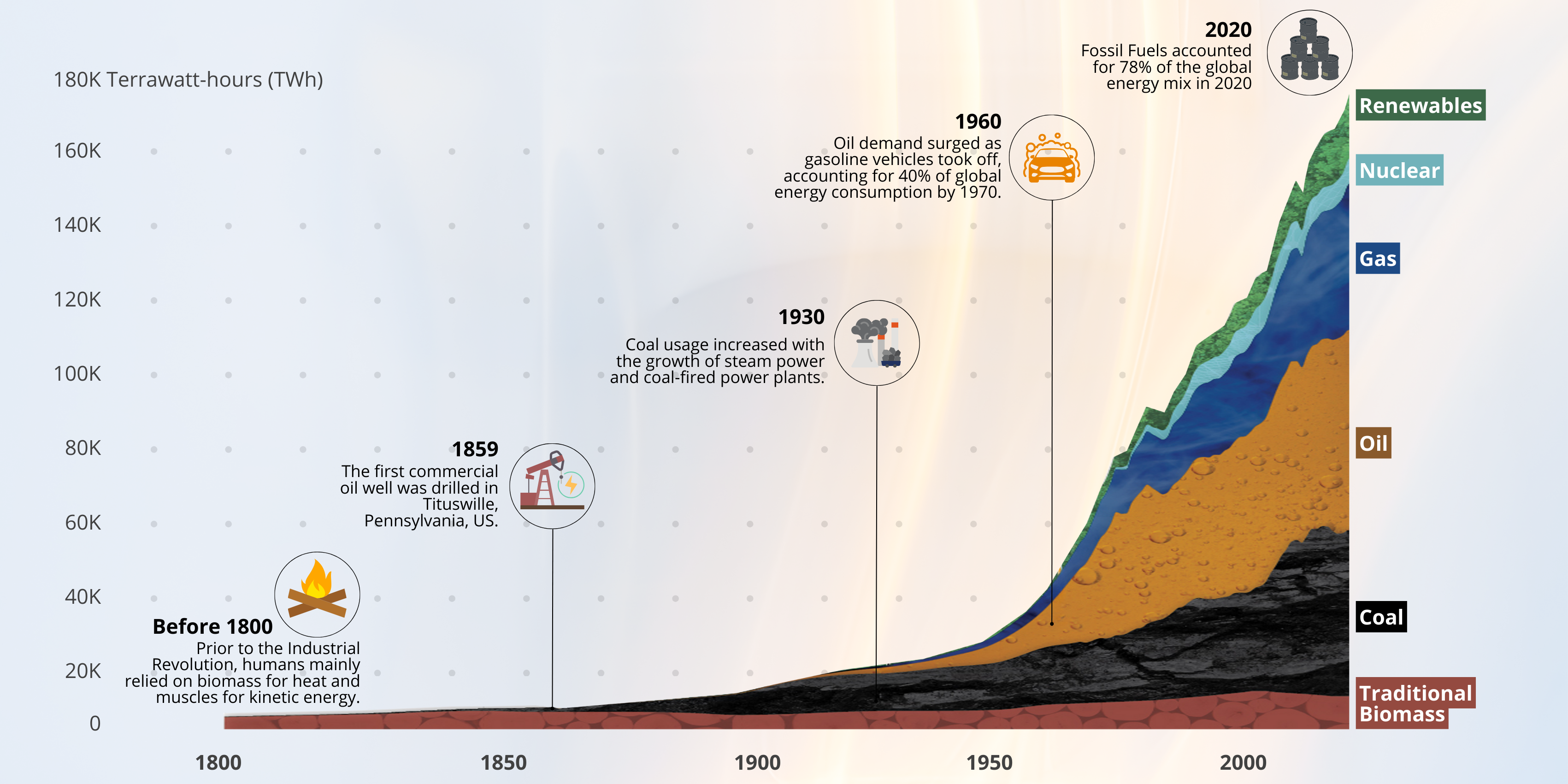

INTELLIGENT ENGINEERING
The term ‘Energy Transition’ refers to the global shift from an energy system based on fossil fuels (currently 80% of the world’s energy) – to a largely renewable energy-based system. The primary goal of the transition is to reduce greenhouse gas emissions to alleviate the future effects of climate change by exchanging carbon-heavy fossil fuels such as coal, oil, and natural gas for clean, renewable energy sources. To enable this shift to less carbon-intensive energy production, countries and companies are setting ambitious targets to lower carbon emissions and move towards net zero in the next few decades. This change will require infrastructure development and expansion to increase electric energy use for a broader range of uses, such as heat pump technology and electric vehicle charging stations.
The energy transition will require changes to be made across every industry, one key change is the requirement to improve energy efficiency in buildings, both commercial and residential. Improved energy efficiency in these areas will allow a reduction of input energy and hence cost reduction. For example, a study found that a 1⁰C reduction in household temperature can produce an annual energy saving of 13%. Additionally, new and innovative renewable energy technologies will need to be developed to access the difficult-to-decarbonise sectors such as aviation, energy storage, and upgrading the power grid to cope with intermittent renewable input.
The rate of transition to renewable energy varies both globally and between industries. However, the direction is clear. With governments worldwide committing to the Paris Agreement of Net-Zero by 2050 to maintain global temperature increase below 1.5⁰C, it is evident that progress will continue to be made to reduce humanity’s global footprint to avoid the most devastating effects of climate change.
The History of Energy Transition
Over time there have been multiple energy transitions, with the current shift towards renewables being only the most recent in a journey starting in the Elizabethan Era when the British began to mine coal. Prior to this point, the primary source of heat energy was biomass – wood and dried manure – and kinetic energy was provided solely by muscles. This was replaced by coal usage, which coincided heavily with the Industrial Revolution, as the steam engines of the day were heavily reliant on energy-dense coal.
It wasn’t until 1859 that the second energy transition occurred with the discovery of oil in Pennsylvania. Oil possesses advantageous attributes, including exceptional energy output per unit volume, straightforward infrastructure for transport and storage, and a wide range of applications. However, before the invention of the internal combustion engine in automobiles, the demand for oil was primarily for lamps, and hence the demand was much lower.
The use of fossil fuels – coal, oil, and gas – continues to this day but has been increasingly outsourced to power stations as more home appliances and transport become electrified. This electrification opened the door for the most recent Energy Transition, renewables.
The energy transition to renewables is an incredibly recent event, with the percentage of energy coming from renewables increasing by just 1.1% between 2000-2010 to 7.7%. However, with clean energy investment outweighing that of fossil fuels since 2016, renewables are bound to become the primary source of energy in no time. In 2023 alone, 1,740 billion USD were invested in clean energy.

What is the Current Energy Transition Strategy
Most individual countries and companies have their own strategies to manage the energy transition, these tend to aim for a Net-Zero target. These targets tend to vary depending on company size and industry and between countries, but most are in line with the United Nations Paris Agreement, which calls for emissions to be reduced by 45% by 2030 and reach Net Zero by 2050.
There are a multitude of ways to reduce emissions depending on the industry, needs, and surrounding environment. One way heating energy can be replaced is by heat pumps. The source of heat energy can be varied between – or a combination of - geothermal, hydrothermal, and air sources depending on the energy requirements and available energy.
Due to many renewable heating sources having particularly low efficiencies, it means that at present – for the most extreme weather conditions – there is still a reliance on fossil fuels. This situation raises a common issue with renewable energy systems of undependability in certain scenarios. Hence, fossil fuels are still relied upon due to their storage ability and accessibility in all circumstances. Steps are being made in regard to energy storage, allowing energy to be stored until required. Hydrogen options are also being investigated, with many manufacturers now ‘future-proofing’ their boilers by making them hydrogen-ready.
Listed things currently assisting the energy transition
- Falling costs and improving technology for renewable energy like solar, wind, and energy storage.
- Advances in technologies like green hydrogen, sustainable aviation fuels, battery storage, small modular nuclear reactors, and carbon removal techniques. These innovations can assist sectors harder to electrify.
- Policy support and carbon pricing mechanisms. Many countries have implemented policy incentives, mandates, and carbon taxes to encourage the shift to clean energy and reduce greenhouse gas emissions. Many governments also provide grant schemes and bursaries to allow the implementation of renewable energy technology to become more economically feasible.
- Increasingly companies have pledged to source 100% renewable electricity and set climate targets, using their purchasing power to push for clean energy development.
- Electric vehicle sales are growing around the world, assisted by government incentives and targets, as well as commitments from major automakers to electrify their lineups. For example, the UK has banned the sale of new internal combustion engine vehicles after 2035.
- Countries representing over 70% of global GDP have now committed to phase out coal power, recognizing coal as incompatible with climate targets.
How Energy Transition Impacts the Economy and Society
Our journey towards sustainable energy isn't just a tech shift; it's a game-changer reshaping how we live and do business. Think of it as a leap towards a future where our energy sources don't just power our homes but transform our economies and communities.
For example, renewables account for more than 50% of global capacity additions over the last decade (8). Solar Energy has also made its mark on the world; the average per capita solar energy consumption in 2022 stood at 432 kWh. Australia, however, currently lead globally, with an average of a whopping 3,868 kWh per person.
But let's zoom into a more macro perspective and consider society. How do we make this transition not solely for economic purposes but also to build societies? Can renewable energy projects bring affordable, clean power to all, closing the energy gap for those left behind?
It's not just about solar panels; it's about sparking economies and making sure everyone gets a seat. It's about crafting policies that save the planet, uplift economies, and unite societies. Solar power is skyrocketing with an increase of 26% up to 270 TWh in 2022, and global investments in renewable energy are hitting 1.3 trillion USD (2022).
Let's explore how this energy shift isn’t just changing how we power our world but rewriting the rules of our economies and societies. These questions aren’t just food for thought; they’re guiding us towards a future where sustainable energy isn't a luxury but a force for change and inclusion.
Listed impacts that energy transition has
Stepping into the energy transition world touches every bit of life around us. We've seen the surge in renewable energy, but what’s the real deal behind it? Here are a few of the impacts that are reshaping our journey towards a greener tomorrow:
- Eco-Harmony:
This is where it all begins. Less carbon in the air, a cleaner environment—switching from fossil fuels to renewable sources helps keep our planet healthier. - Economic Momentum:
Jobs become available in renewable energy sectors, local economies get a boost from clean tech projects, and the promise of long-term savings kicks in as we move towards sustainable energy solutions. - Societal Equity and Access:
It’s not just about numbers; it’s about people. Cleaner air and better health no matter where you live. It's about levelling the field and ensuring everyone benefits from the shift towards cleaner energy. - Innovative Horizons:
Shifting energy sources isn’t just a swap; it’s an invitation for leaps in technology. Advances in renewable tech and energy storage solutions are leading us to a smarter, greener future. - Policy and Global Shifts:
From supportive measures to global commitments, policies are shaping an energy narrative that’s not just about markets but about changing mindsets.
This is just a peek into the wide-reaching impact of embracing sustainable energy. It’s a collection of changes reshaping our environment, economies, societies, and sketching out our future.
Why is Energy Transition so Important?
The energy transition is vital for upholding climate stability. Studies show that transitioning to renewable energy could reduce CO2 emissions by up to 90%, a pivotal step towards environmental resilience.
Additionally, energy transition bolsters nations' energy security by decreasing dependency on imported fossil fuels. By diversifying energy sources, countries become less susceptible to supply disruptions. This also reduces reliance on fluctuating global oil and gas prices.
Furthermore, renewables offer long-term sustainability compared to finite fossil fuel reserves. Projections estimate renewables could provide over 35% of global energy by 2025, demonstrating their potential as an enduring energy supply.
Finally, energy transition aligns with international climate agreements like the Paris Accord. Modelling suggests fully implementing these accords could catalyze 1.1% annual GDP growth globally through 2030. This highlights the economic upside of ambitious climate action.
What EPConsult Energies Can Offer in Your Energy Transition
As the urgency for a sustainable and green energy transition intensifies globally, EPConsult Energies (EP) stands at the forefront, offering comprehensive solutions tailored to meet these challenges. EP's expertise not only addresses the immediate needs but also paves the way for future sustainability.
Take, for instance, one of our recent projects for the Isuzu Bedford Company Vehicles Limited factory, a Stellantis-owned facility in Luton. This project exemplifies our multifaceted approach, which can be adapted to various industries and requirements. Key aspects of their work included:
- Basic Evaluation: Analysis of current water heating systems, energy consumption, costs, and compliance with UK laws and regulations.
- Geothermal Assessment: Evaluating the water table and chalk water wells for available energy, considering soil permeability, pluviometry, climatology, water composition, and aquifer temperatures.
- Thermal Impact Analysis: Assessing the thermal impact on groundwater, interferences, and designing sustainable geothermal heat pump solutions.
- Alternative Heat Source Review: Examining existing ventilation and heating systems, cold-water supply, building air tightness, heat pumping systems, heat recovery units, and heat storage options.
- Low-Carbon Thermal Generation: Analysis of aerothermal heat pumps and other low-carbon options.
This project is a testament to our ability to deliver a broad spectrum of services in the energy transition domain, showcasing our commitment to innovation and environmental stewardship.
In summary, energy transition is essential for climate stability, energy security, sustainability, and meeting global commitments. It entails fundamentally redesigning our energy systems to build a cleaner and more technologically advanced world. Energy transition is thus not just an option, but an urgent necessity.
To explore how EP can assist you with your project, please reach out to our specialists. For more information, contact us today.
References
- Description of Fossil Fuels
- Energy Savings Small Changes - UK Gov
- The Paris Agreement - UNFCCC
- Economic Seminar Papers - University of Cambridge
- History of Energy Transitions - WEF
- World Energy Investment 2023 - IEA
- UK Ban on New Petrol and Diesel Cars - RAC
- Power Generation from Renewables - ScienceDirect
- Solar Statistics - Heatable
- Solar PV - IEA
- Global Landscape of Renewable Energy Finance 2023 - IRENA
- Transforming Energy System and Reducing Carbon Emissions - IRENA
- Electricity Generation from Renewables - WEF
- Measuring the Economics of IRENA 2016
Theodore Lunny and Kerem Yasar
EPConsult Energies | INTELLIGENT ENGINEERING
More insights:

Hydrogen Challenges and Solutions
Hydrogen, with a history intertwined with the energy sector for over two centuries, is witnessing a remarkable resurgence, particularly as a renewable energy source in the UK's transition from fossil fuels. As the momentum around hydrogen energy grows, so does the question of its safety. While all fuels inherently pose some risks, hydrogen's unique properties, such as a wide range of flammable concentrations and lower ignition energy, necessitate additional engineering controls and careful material selection.

UK's Electric Vehicle Revolution
In a landmark decision that marked the beginning of the UK's Electric Vehicle (EV) Revolution, the UK government announced in November 2020 the cessation of sales of petrol and diesel-fueled vehicles by 2030, and hybrid vehicles by 2035. This unprecedented shift, aimed at significantly reducing the country's carbon footprint, has set the stage for a monumental transition in the transport sector, which accounted for 24% of the UK's total emissions in 2020.

Blowing Away the Carbon
There are several technical and economic reasons that offshore wind power is a viable option for decarbonizing traditional oil and gas production. Firstly, new offshore wind license areas are often located in deeper waters and at greater distances from the coast. Once land is reached, these sites are still far from potential markets. These logistical factors drive up the cost of delivering power to onshore users.

Common Myths About Solar Energy
The myths and misconceptions surrounding solar energy often need to be updated or stem from a lack of understanding of the technology. Solar energy remains efficient in less-than-ideal weather conditions, and while initial costs can be high, the long-term financial benefits are substantial. Furthermore, although the manufacturing process of solar panels does have an environmental impact, the overall effect is far less damaging than traditional energy sources.

From Coal Mines to Clean Energy
The commitment to net zero has impacted all sectors, promoting the need for low-carbon technologies. Around the UK, a vast number of decommissioned facilities are standing disused in previous industrial hubs, and this will only become more common over the coming years as more and more carbon-polluting facilities are closed. More recently, there has been research and investment on how these sites could be used to develop renewable energy sites.

Riding The Waves of Energy
The ocean is a vast playground of untapped energy. Waves, created by the wind's interaction with the water's surface, hold immense potential. Wave energy, also known as ocean wave power, aims to capture this power and convert it into usable electricity. It's like harnessing the ocean's natural heartbeat to power our world. The energy held within the world's waves is the most significant unused power source on the planet, with the total energy potential globally believed to reach a staggering 30,000 TWh per year. To put this into perspective, that's tenfold the European Union's total annual electricity usage.
- Log in to post comments
